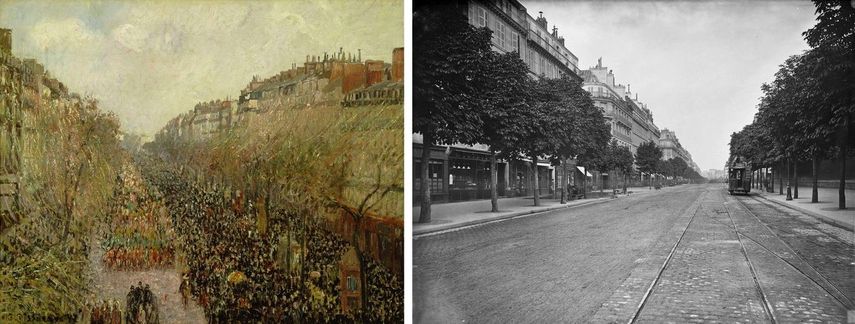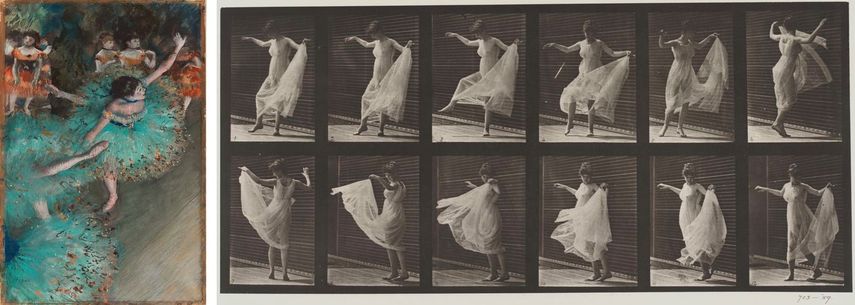How Did the Invention of the Camera Effect Artists Approach to Making Art
In 1839, a new means of visual representation was announced to a startled world - photography. While photographers themselves spent the ensuing decades experimenting with techniques and debating the nature of this new invention, its bear on on modern lodge proved immense.
Today, it might exist difficult to appreciate how revolutionary and challenging photography was, merely when information technology first stepped into the scene, the art earth quickly took notice. What started as a competition shortly became an alliance of vision that changed the way we come across forever. Information technology radically changed how artists, specially the Impressionist painters, looked at the globe and depicted reality.
The upcoming exhibition at the Museo Nacional Thyssen-Bornemisza examines the repercussions the invention of photography had on the evolution of the visual arts in the second half of the nineteenth century. TitledThe Impressionists and Photography, it brings together66 oil paintings and works on newspaper and more than 100 photographs, offering a disquisitional reflection on the affinities and mutual influences betwixt painting and photography, including the contend information technology sparked among critics and artists.

A New Mode of Looking At the World
Post-obit the appearance of the first daguerreotypes in the late 1830s and the subsequent discovery of techniques for making photographic prints on newspaper, a very close relationship was established between photography and painting. The artificial center of the camera of photographers such as Gustave Le Grayness, Eugène Cuvelier, Henri Le Secq, Olympe Aguado, Charles Marville and Félix Nadar spurred Édouard Manet, Edgar Degas and the young painters of Impressionism Camille Pissarro, Paul Cézanne, Alfred Sisley, Claude Monet, Marie Bracquemond, Pierre-Auguste Renoir, Berthe Morisot and Gustave Caillebotte to devise a new way of looking at the globe.
As photography evolved from a mere mechanical means of reproducing reality to gaining creative brownie, it immune painters a closer exam of low-cal and asymmetrical, cropped spaces, as well as an exploration of spontaneity and visual ambiguity. This relationship was mutual, as the medium of photography became concerned with the materiality of their images and sought methods for making their photographs less precise and more than painterly. Painters of Impressionism were keenly aware of the transient nature of reality and, for them, photography seemed to mark a symbolic victory of man over temporality and triggered a revolutionary transformation in their depictions.

The Range of Artistic Concerns
To illustrate the artistic concerns shared by painters and photographs and new artistic freedoms that emerged from their relationship, The Impressionists and Photography is divided into nine sections.
The departmentThe Forest compares the landscape paintings of the forerunners of Impressionism, such as Gustave Courbet, Camille Corot, Théodore Rousseau and Charles Daubigny, with the photography piece of work of Le Greyness, Cuvelier and Le Secq, who carted their photographic equipment into the forest. The influence of photography is visible in the painters' instantaneous arroyo to their subject thing, their asymmetrical compositions and the effects of lite filtering through the copse.
In the section Figures in the Landscape, the visitors can see the comparisons between Manet'south schematic mural backgrounds and the decorative backdrops used in photographic portraits, such as those made fashionable by Aguado or between the outdoor portraits of the relatives of Frédéric Bazille and the photographic group portraits made by Édouard Baldus.
In the section The Water, we can run across Le Grey's seascapes, constructed closeups of choppy seas and clouds off the declension of Normandy, brought into dialogue with various pictures of seas and skies painted by Eugene Louis Boudin and Monet, but also comparisons between the ghostly reflections of the trees in the tranquil river waters in the photography work of Aguado and Camille Silvy and the works of Monet and Sisley.
Leisure activities in the countryside and outdoor scenes are the subjects of the section In the Countryside. It juxtaposes the instantaneous and fragmentary approach to the scene past artists such as Renoir, Sisley, Monet and Caillebotte and the fashion in which photographers such equally Achille Quinet, Eugène Atget and Charles Marville captured reality.
In the mid-19th century, several photographers such as Baldus, Le Gray and the Bisson brothers were hired by the French government to take photographs of the historical monuments of France. Years later, these pictures aroused the interest of the Impressionists on business relationship of the Gothic buildings, every bit visible in Claude Monet'southward depictions of the façade of Rouen cathedral. This is the subject of the section titled The Monuments.
In the section The City, we run across modern urban views past Gustave Le Gray, Charles Soulier and Adolphe Braun that are institute after in the paintings of Berthe Morisot and Gustave Caillebotte, as well as a dialogue between Charles Marville's photography piece of work and Camille Pissarro'south paintings of the boulevards.
The fast growth of commercial photography and the ascent of portrait photographers such as Nadar steered painted portraits in a new direction. The section The Portrait shows works of Manet, Cézanne and Degas that were based on photographs of their sitters at certain stages.
The Body features naturalistic, spontaneous poses photographed past Le Gray and Paul Berthier alongside a choice of nudes painted by the painters of the Impressionism, peculiarly Degas, the almost photographic of the group of painters.
The exhibition concludes with the department The Archive, featuring a group of photographs of Manet's works taken by Anatole-Louis Godet, commissioned by the painter himself who colored some with watercolors. The concluding piece on evidence is the album Vingt Dessins, a miniature retrospective published in 1897 featuring a pick of 20 chromogravures of Degas' works selected by the artist himself.

The Impressionists and Photography at Museo Nacional Thyssen-Bornemisza
Impressionists and Photography will be on view at the Museo Nacional Thyssen-Bornemisza in Madrid from October 15th, 2019 to January 26th, 2020.
Curated by the museum's Paloma Alarcó, chief curator of Mod Painting, andClara Marcellán, curator of the Department of Modern Painting, it is accompanied past a catalog with texts by Paloma Alarcó; digital publication in the Quiosco Thyssen app and educational guide with texts by Clara Marcellán.





Featured paradigm: Eugène Boudin - Harbor of Brest, 1870. Oil on canvas. 47.six x 65.4 cm. Portland Art Museum, Oregon. Bequest of Charles Francis Adams © Portland Art Museum. All images courtesy Museo Nacional Thyssen-Bornemisza.
Source: https://www.widewalls.ch/magazine/impressionists-photography-museo-thyssen-bornemisza#:~:text=As%20photography%20evolved%20from%20a,of%20spontaneity%20and%20visual%20ambiguity.
0 Response to "How Did the Invention of the Camera Effect Artists Approach to Making Art"
Publicar un comentario